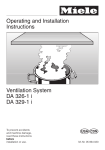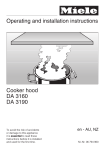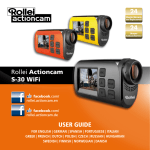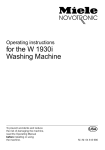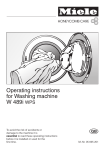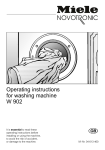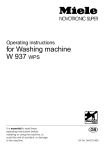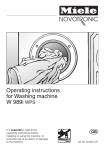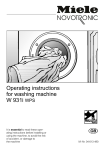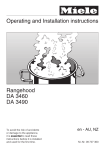Download Miele H 326 Technical data
Transcript
Operating and Installation Instructions for cooker hoods DA 326 i, DA 326 i EXT DA 327 i, DA 327 i EXT DA 329 i, DA 329 i EXT It is essential to read these operating and installation instructions before installing or using the machine, to avoid the risk of accident or damage to the machine. Q\@ä} M.-Nr. 05 473 620 Contents Contents Caring for the environment . . . . . . . . . . . . . . . . . . . . . . . . . . . . . . . . . . . . . . . . . . 3 Warning and Safety instructions . . . . . . . . . . . . . . . . . . . . . . . . . . . . . . . . . . . . . 4 Guide to the appliance. . . . . . . . . . . . . . . . . . . . . . . . . . . . . . . . . . . . . . . . . . . . . . 8 Description of the functions . . . . . . . . . . . . . . . . . . . . . . . . . . . . . . . . . . . . . . . . 10 Operation . . . . . . . . . . . . . . . . . . . . . . . . . . . . . . . . . . . . . . . . . . . . . . . . . . . . . . . 11 Cleaning and care Housing . . . . . . . . . . . . . . . . . . . . . . . . . . . . . . . . . . . . . . . . . . . . . . . . . . . . . . . . . 12 Grease filters . . . . . . . . . . . . . . . . . . . . . . . . . . . . . . . . . . . . . . . . . . . . . . . . . . . . . 12 Primary filter . . . . . . . . . . . . . . . . . . . . . . . . . . . . . . . . . . . . . . . . . . . . . . . . . . . 13 Secondary filter . . . . . . . . . . . . . . . . . . . . . . . . . . . . . . . . . . . . . . . . . . . . . . . . . 13 Fitting / replacing the active charcoal filter . . . . . . . . . . . . . . . . . . . . . . . . . . . . . . 15 Defective lighting . . . . . . . . . . . . . . . . . . . . . . . . . . . . . . . . . . . . . . . . . . . . . . . . . 16 After sales service . . . . . . . . . . . . . . . . . . . . . . . . . . . . . . . . . . . . . . . . . . . . . . . . 17 Appliance dimensions . . . . . . . . . . . . . . . . . . . . . . . . . . . . . . . . . . . . . . . . . . . . . 18 Installation Fitting accessories . . . . . . . . . . . . . . . . . . . . . . . . . . . . . . . . . . . . . . . . . . . . . . . . . 22 1. Non-return flap . . . . . . . . . . . . . . . . . . . . . . . . . . . . . . . . . . . . . . . . . . . . . . . . . . 24 2. Reducing collar . . . . . . . . . . . . . . . . . . . . . . . . . . . . . . . . . . . . . . . . . . . . . . . . . 25 3. Runners . . . . . . . . . . . . . . . . . . . . . . . . . . . . . . . . . . . . . . . . . . . . . . . . . . . . . . . 25 4. Fit the furniture door . . . . . . . . . . . . . . . . . . . . . . . . . . . . . . . . . . . . . . . . . . . . . . 26 5. Position the appliance in the wall unit . . . . . . . . . . . . . . . . . . . . . . . . . . . . . . . . 27 6. Align the height of the appliance . . . . . . . . . . . . . . . . . . . . . . . . . . . . . . . . . . . . 27 7 a. Fitting a DFB lightshield . . . . . . . . . . . . . . . . . . . . . . . . . . . . . . . . . . . . . . . . . 28 7 b. Fitting a lightshield to match the kitchen furniture . . . . . . . . . . . . . . . . . . . . . 28 8. Align the depth of the appliance . . . . . . . . . . . . . . . . . . . . . . . . . . . . . . . . . . . . 29 9 a. Fit side spacers at the sides of the appliance . . . . . . . . . . . . . . . . . . . . . . . . 30 9 b. Spacer strip for the rear of the appliance . . . . . . . . . . . . . . . . . . . . . . . . . . . . 30 9 c. Light cover . . . . . . . . . . . . . . . . . . . . . . . . . . . . . . . . . . . . . . . . . . . . . . . . . . . 31 10 a. Set up for vented extraction . . . . . . . . . . . . . . . . . . . . . . . . . . . . . . . . . . . . . 32 10 b. Set up for recirculation connection . . . . . . . . . . . . . . . . . . . . . . . . . . . . . . . . 32 11. Electrical connection . . . . . . . . . . . . . . . . . . . . . . . . . . . . . . . . . . . . . . . . . . . . 33 Special fitting instructions Fitting into wall unit with 19 mm thick carcase sides . . . . . . . . . . . . . . . . . . . . 33 Installing in a 70 or 90 cm wide wall unit . . . . . . . . . . . . . . . . . . . . . . . . . . . . . 34 Connection for air extraction . . . . . . . . . . . . . . . . . . . . . . . . . . . . . . . . . . . . . . . 36 Electrical connection . . . . . . . . . . . . . . . . . . . . . . . . . . . . . . . . . . . . . . . . . . . . . . 37 Technical data . . . . . . . . . . . . . . . . . . . . . . . . . . . . . . . . . . . . . . . . . . . . . . . . . . . 39 2 Caring for the environment Caring for the environment Disposal of packing material Disposal of your old appliance The transport and protective packaging has been selected from materials which are environmentally friendly for disposal and can normally be recycled. Old appliances contain materials which can be reclaimed or recycled. Please contact your dealer, your waste collection centre or scrap merchant about potential recycling schemes. Ensure that any plastic wrappings, bags etc. are disposed of safely and kept out of the reach of babies and young children. Danger of suffocation! Rather than just throwing these materials away, please ensure they are offered for recycling. Ensure that the appliance presents no danger to children while being stored for disposal. See the appropriate section in the Warning and Safety instructions. 3 Warning and Safety instructions Warning and Safety instructions This appliance conforms to current safety requirements. Inappropriate use could, however lead to risk of accidents to the user and damage to the appliance. Before using this appliance for the first time read the operating instructions carefully. They contain important information on safety, use and maintenance of the appliance. This way you will avoid the risk of accidents and damage to the appliance. Keep these operating instructions in a safe place and ensure that new users are familiar with the content. Pass them on to any future owner. Appropriate use The appliance is intended for domestic use only. The manufacturer cannot be held responsible for any damage caused by improper use or by non-observance of these instructions. 4 Technical safety Before connecting the cooker hood to the mains supply make sure that the voltage and frequency details given on the data plate correspond with the on-site electricity supply, otherwise the appliance could be damaged. If in doubt consult a qualified electrician. The electrical safety of this appliance can only be guaranteed when continuity is complete between the appliance and an effective earthing system which complies with local and national regulations. It is most important that this basic safety requirement is tested by a qualified electrician. The manufacturer cannot be held responsible for the consequences of an inadequate earthing system (e.g. electric shock). Installation work and repairs may only be carried out by suitably qualified and competent persons to ensure safety. Repairs and other work by unqualified persons could be dangerous and the manufacturer will not be held responsible. Warning and Safety instructions The appliance is only completely isolated from the mains supply when: – it is switched off at the fused spur connection, or – it is switched off at the wall socket and the plug has been withdrawn (do not pull on the cable, only on the plug), or – the mains fuse is withdrawn. Ensure current is not supplied to the appliance while maintenance or repair work is being carried out. Do not connect the appliance to the mains electricity supply by an extension lead. Extension leads do not guarantee the required safety of the appliance (e.g. danger of overheating). Use of the appliance Do not let small children play with the appliance or its controls. Supervise its use by the elderly or infirm. When fitted above an open grill the cooker hood must not be used in recirculation mode. by the suction of the cooker hood, parts of which could then be damaged. Always switch the cooker hood on when a cooking zone is in use, otherwise condensation may collect in the hood, which could cause corrosion. When cooking with oil or fat, chip pans and deep fat fryers etc, do not leave the pans unattended. Never leave an open grill unattended when grilling. Overheated oil and fat can ignite and could set the cooker hood on fire. Do not use the cooker hood without the grease filter in place. This way you will avoid the risk of grease and dirt getting into the appliance and hindering its smooth operation. Clean or change the filter regularly. An over-greasy filter is a fire hazard. Under no circumstances use a steam cleaner to clean this appliance. Pressurised steam could reach the electrical components and cause a short circuit. Never use an open flame beneath the cooker hood. To avoid the danger of fire do not flambé or grill over an open flame. When switched on the cooker hood could draw flames into the filters. Fat particles drawn into the cooker hood present a fire hazard. When using the cooker hood over a gas hob ensure that any burners in use are always covered by a pan. Otherwise flames could be drawn up 5 Warning and Safety instructions Installation – The distance between the top of the cooker/hob and the bottom of the cooker hood must measure at least: – 45 cm above electric cookers/hobs, – 65 cm above gas cookers/hobs, – 65 cm above a Miele or Imperial electric open grill. For other manufacturer’s cooking appliances maintain the safety distance as recommended in their Installation and Operating instructions. If more than one appliance is fitted beneath the cooker hood and they have different minimum safety distances to the cooker hood, select the higher distance. Safety regulations prohibit the fitting of a cooker hood over solid fuel stoves. All ducting, pipework and fittings must be of non-flammable material. These can be obtained from the Miele Spare Parts department or from builders’ merchants. The appliance must not be connected to a chimney or vent flue which is in use. Neither should it be connected to ducting which ventilates rooms with fireplaces. If exhaust air is to be extracted into a chimney or ventilation duct no longer used for other purposes, take professional advice. 6 Warning and Safety instructions When using the cooker hood at the same time as another heating appliance which depends on the air in the room, (e.g. gas, oil or coal fired heaters, continuous flow or other water heaters, gas cooker, gas hob or gas oven) special care must be taken, as the action of the cooker hood extracts air from the room, which these types of heater need for combustion. In countries where there are areas which may be subject to infestation by cockroaches or other vermin, pay particular attention to keeping the appliance and its surroundings in a clean condition at all times. Any damage which might be caused by cockroaches or other vermin will not be covered by the appliance guarantee. Appliances with external fans In order to ensure safe operation, and to prevent the gases given off by the heating appliances from being drawn back into the room when the extractor and the heater are in operation simultaneously, an underpressure in the room of 0.04 mbar (4 pa) is the maximum permissible. Ventilation can be maintained by air inlets which cannot be blocked, in windows, doors and outside wall vents, or by other technical measures, such as ensuring that the extractor can only be switched on when the heating appliance is switched off or vice-versa. N.B.: The overall ventilation condition of the dwelling must be taken into account. If in any doubt, the advice of a competent builder or, for gas, a “Corgi” installer (gas installer) must be sought. If the cooker hood is used in recirculation mode (with active charcoal filters) , there are no restrictions. For appliances with an external fan motor fitted (EX models) the connection of the two units must be made using the connection cable and the plug connectors. Make sure the correct combination of the two appliances has been selected. Separate instructions are supplied with the external fan. Disposal of your old appliance Before discarding an old appliance switch off and disconnect it from the power supply. Cut off and render any plug useless. Cut off the cable directly behind the appliance to prevent misuse. This should be done by a competent person. The manufacturer cannot be held responsible for any damage caused by non-observance of these instructions. 7 Guide to the appliance Guide to the appliance 8 Guide to the appliance b Exhaust stub ø 150 mm c Active charcoal filter slot d Control panel e Pull-out deflector plate f DFB lightshield (Special accessory; supplied as standard in Australia) g Secondary grease filter h Hob illumination i Primary grease filter j Light switch for hob illumination k On/Off switch for the fan l Power level switches You can select one of three power levels or an intensive level, depending on how much the air needs to be filtered. 9 Description of the functions Description of the functions The cooker hood works . . . by air extraction: The air is drawn in, cleaned by a primary filter and then passed through a secondary filter before being directed outside. The cooker hood is fitted with a nonreturn flap . This flap is closed when the cooker hood is switched off. No exchange of room air and outside air can take place. When the cooker hood is switched on the non-return flap opens for the cooking smells to be blown directly outside. . . . by air recirculation: The air is drawn in and cleaned first by the primary filter, then the secondary filter before passing through an active charcoal filter. The cleaned air is then recirculated back into the kitchen through a vent in the top of the cooker hood. Before using the cooker hood for the first time in recirculation mode, ensure that the active charcoal filter is in place. See Section on "Cleaning and care". 10 . . . with an external fan The EX models are designed to be connected to an external fan located outside the room. The external fan is connected to the cooker hood by a control cable and is operated by the control panel on the cooker hood. Operation Operation To switch the fan on To switch the fan off Pull the deflector plate out approx. 5 cm. The cooker hood will then begin to operate at power level “II”. Press the On/Off switch to turn the fan off Selecting the power level Depending on how much the air needs to be filtered, there are four power levels available. For normal cooking a low to medium level is usually sufficient. For frying or cooking food with a strong aroma the highest level is recommended. or Push the deflector plate back in. The next time the deflector plate is pulled out the cooker hood will operate at power level “II”. Switching the lighting on or off The lighting for illuminating the hob can be switched on or off independently of the fan. Lower level Pull the deflector plate out approx. 3 cm. Higher level Use the power level switches to select the power level required. The indicator lamps show which power level has been chosen. Press the switch for the lighting. When the lighting is switched on the indicator light above the switch comes on. To switch the lighting off: Press the switch for the lighting again or Push the deflector plate back in. The next time the deflector plate is pulled out the light will come back on. 11 Cleaning and care Cleaning and care Before any cleaning or maintenance work the cooker hood must be disconnected from the mains supply. Ensure that: - it is switched off at the fused spur connection or - it is switched off at the wall socket and the plug has been withdrawn (do not pull on the cable, only on the plug), or - the mains fuse is withdrawn. Ensure current is not supplied to the appliance while maintenance or repair work is being carried out. Housing The surfaces can be cleaned using hot water to which a little mild washing-up liquid has been added. Dry with a soft cloth. Never use cleaners which scour or contain chlorine, acids or soda. These would damage the surface of the cooker hood. For stainless steel surfaces a mild nonabrasive proprietary stainless steel cleaner is suitable. 12 Grease filters Re-usable metal filters are fitted which remove solid particles (oil, dust, etc.) from the kitchen vapours, preventing soiling of the cooker hood. The cooker hood has a primary filter which is visible on the underside of the appliance. A secondary filter is situated above it in the appliance. The filters should be cleaned regularly (at least every 3-4 weeks) to avoid a build-up of fat. Important! Always clean both filters. An over saturated filter is a fire hazard. Cleaning and care Primary filter To remove the primary filter pull the deflector plate out slightly. Switch the fan off. Clean the filters – – by hand: with a nylon brush in a mild solution of hot water and washing up liquid. – in a dishwasher: place the filters with the short side upright in the lower basket, ensuring the spray arm is not obstructed. Holding the primary filter at the front, tilt it approx. 3 cm downwards and then pull it towards you to remove it. Secondary filter Pull the deflector plate out to its full extension. The secondary filter will now be visible. DA 327, 329: The primary filter can be folded up if necessary to get it in the dishwasher. To do this open the catches in the middle of the filter. Depending on the cleaning agent used, cleaning the grease filters in a dishwasher can cause permanent discolouration to the surface of the filters. However, this will not affect the functioning of the grease filters in any way. After cleaning, leave the filters to dry on an absorbent surface before putting them back in place. Holding it by the handle pull it downwards to remove it. When removing the filters for cleaning also clean off any residues of oil or fat from the now accessible housing to prevent the risk of these catching fire. 13 Cleaning and care Replacing the filters Secondary filter: Fit the filter into the appliance so that it hooks into position at the back, then push it upwards at the front and make sure it engages in position on the left and right hand sides. Turn the filter so that the red plastic guides are at the front and facing upwards. With the deflector plate pulled out, insert the primary filter from below and hold in position. Primary filter: Press the filter gently upwards and at the same time push the deflector plate in. The filter will slide into its holders. DA 327i, 329i: – Open the catches. – Open out the filter and secure the catches. 14 Cleaning and care Fitting / replacing the active charcoal filter For recirculation mode the active charcoal filter has to be used in addition to the grease filters. It is designed to absorb cooking odours. The active charcoal filter is fitted into a slot on the front of the appliance housing. Active charcoal filters can be obtained from your dealer or the Miele Spare Parts Department. Refer to the section “Technical data” for type and reference number. Follow the instructions supplied with the active charcoal filter when fitting it. Replace the filter when it no longer absorbs kitchen odours effectively. It should, however, be replaced at least every 6 months. 15 Cleaning and care Defective lighting If the lighting does not work the light tube may need replacing or the starter could be defective. Before any cleaning or maintenance work the cooker hood must be disconnected from the mains supply. Ensure that: - it is switched off at the fused spur connection or - it is switched off at the wall socket and the plug has been withdrawn (do not pull on the cable, only on the plug), or - the mains fuse is withdrawn. Ensure current is not supplied to the appliance while maintenance or repair work is being carried out. Take out the primary filter as already described. Unscrew the fixing screws on the right and left hand sides of the light cover. Whilst undoing the screws hold the cover securely so that it does not fall onto the hob. Lower the cover to remove it. Replace the light tube or the starter. Replace the cover and secure in position with the fixing screws. Replace the primary filter. 16 After sales service After sales service In the event of any faults which you cannot easily remedy yourself, please contact: – Your Miele Dealer or – The Miele Service Department, (see address on the back page) When contacting the Service Department, please quote the model and serial number of the appliance, both of which are shown on the data plate, visible when the grease filter is removed. Please note that telephone calls may be monitored and recorded to improve our service. 17 Appliance dimensions Appliance dimensions 18 Appliance dimensions * DFB lightshield is available as a special accessory. (Supplied as standard in Australia) ** With this minimum depth, the back panel of the wall unit housing needs to be removed (see next page). The DA 327 i and 329 i can also be fitted in a 60 cm wide wall housing unit (see wall unit dimensions for DA 326 i). Please note that the deflector plate protrudes at the sides. The building in height of adjacent units must take this into account. – The minimum wall unit height required is 460 mm, to ensure that the exhaust ducting can be fitted to the exhaust stub without difficulty. The slot for the active charcoal filter b must remain accessible if the appliance is being used in recirculation mode. 19 Appliance dimensions Building in depth of the wall unit The depth required will depend on the lightshield and where it is positioned. Appliance with DFB lightshield (Supplied as standard in Australia) If the appliance is to be fitted with the lightshield flush against the front panel of the wall unit the following building-in depth A is necessary: A = min. 273 mm with a 16 mm thick furniture door A = min. 270 mm with a 19 mm thick furniture door 20 Using a lightshield which matches existing kitchen furniture If the appliance is to be fitted into a wall unit in a kitchen run, with a lightshield to match the existing kitchen furniture, then a minimum distance B of 275 mm is required behind the lightshield. Appliance dimensions The side spacer C covers a gap of 10 to 70 mm between the rear of the appliance and the wall. If the wall unit does not have a back panel and there are no units to the side of it then a traverse must be used to provide the unit with extra stability. A traverse is available from the Miele Spare Parts Department in the appropriate width to suit the wall unit (Miele DT 60, DT 70 and DT 90). 21 Installation Installation Fitting accessories 22 Installation b 1 hose clip for securing the vent ducting to the exhaust stub. c 1 reducing collar for exhaust ducting ø 125 mm. 8 screws 4.0x16 mm For securing the runners e in a 60 cm wide wall unit or for securing the spacer blocks f,g in a 70 cm or 90 cm wide wall unit. d 1 non-return flap for fitting into the exhaust stub. e 2 runners (1 x right, 1x left) to support the appliance in the wall unit. f 2 spacer blocks (DA 327 only) for fitting the appliance in a 70 cm wide wall unit. g 2 spacer blocks (DA 329 only) for fitting the appliance in a 90 cm wide wall unit. h 2 cover caps (DA 327/329 only) (1 x right, 1x left) and two inserts i for covering the support rails when when fitting in a 70 or 90 cm wide wall unit. j 2 side spacers to cover the spaces at the side when fitting in a 60 cm wide wall unit. k Facia slot for inserting the active charcoal filter. 6 self-tapping screws 3.5x9.5 mm 2 for securing the light cover n,o 4 for securing the side spacers j. DA 327, 329 only : 8 more screws for securing the runners e to the spacer blocks f,g (when fitting in a 70 or 90 cm wide wall unit) 1 strip with 3 adhesive sections for attaching a kitchen furniture lightshield to grip l. 7 screws 3.0x15 mm 2 for attaching the grip l to the deflector plate; 5 for attaching a kitchen furniture lightshield to grip l. l Grip for the front panel. m 1 spacer strip to cover the gap between the rear of the appliance and the wall. n 1 light cover with right and left holders o. Screwdriver for aligning the furniture door after the appliance has been built in. 23 Installation Safety regulations prohibit the fitting of this cooker hood over a solid fuel stove. The minimum safe distance between the top of the cooker/hob and the bottom of the cooker hood should be at least: – 45 cm above electric cookers / hobs – 65 cm above gas cookers / hobs – 65 cm above a Miele or Imperial electric open grill. See “Warning and Safety instructions” for further notes on safe installation. Fitting procedure 1. Non-return flap (if required) 2. Reducing collar (if required) 3. Fit the runners in the wall unit 4. Fit and align the furniture door 5. Position the appliance in the wall unit 6. Align the height of the appliance 7. Fit the lightshield 8. Align the depth of the appliance 9. Fit the side spacers, the spacer strip, and the light cover 10. Set up for air extraction or recirculation 11. Connect to the electricity supply 24 Prepare the exhaust stub/ vent socket for air extraction or recirculation before installation. 1. Non-return flap Air extraction with integrated fan Fit the non-return flap into the vent socket so that the flaps can open upwards. (This is not necessary if the ducting system is already fitted with a non return flap, e.g. wall vent). Air extraction with external fan The non-return flap is integrated into the vent socket. Recirculation mode When used in recirculation mode it is not necessary to fit a non-return flap. Installation 2. Reducing collar 3. Runners Air extraction The appliance is designed for vent ducting ø 150 mm. If ø 125 mm is required: Place the reducing collar supplied on the vent socket and turn it to secure it in position (see “Connection for air extraction”). Recirculation Place the reducing collar for ø 125 mm on the vent socket as described previously. Now fit the two runners into the wall unit. If the appliance is being installed in a 70 cm or 90 cm wide wall unit the runners are fitted with the spacer blocks. Position the runners The positioning will depend on the type of lightshield being fitted. Appliance fitted with a DFB lightshield: (Supplied as standard in Australia) Draw a vertical line approx. 20 cm long on both the left and right sides of the wall unit 100 mm in from the front edge (see illustration). 25 Installation Appliance fitted with a lightshield to match the kitchen furniture: Fit the runners (Standard wall unit: 60 cm wide, 16 mm thick carcase sides) Hold the runner against the wall unit ensuring that the lower edge of the runner is flush with the wall unit. The first row of screws must be aligned against the marked line. The “16 mm" marking should face upwards. Secure each runner with four 40 x 16 mm screws. To calculate the position of the lightshield: Measure the distance “B” from the front of edge of the wall unit (without door) and the rear edge of your lightshield. Then draw a vertical line approx. 20 cm long on both the left and right side panels of the wall unit for dimension "C". If dimension “B” is less than 20 mm, dimension “C” will be 100 mm. If dimension “B” is between 20 and 40 mm, dimension “C” will be 124 mm. If the appliance is fitted into a Miele kitchen furniture wall unit and fitted with a lightshield to match, the necessary drill holes will already be provided in the wall unit. 26 Exception: Please refer to the notes under “Special fitting instructions” at the end of the “Installation” section for instructions on fitting the appliance into a wall unit with 19 mm thick carcase sides or into a 70 cm or 90 cm wide wall unit. 4. Fit the furniture door Before building in the appliance, fit and align the wall unit furniture door. Use the special tool supplied, if you need to re-align the furniture door after the appliance has been built in and the hinges are no longer accessible. Installation 5. Position the appliance in the wall unit Lift the cooker hood into the wall unit, making sure that the supports on the cooker hood are sitting on the runners in the wall unit. Push it into the wall unit as far as it will go. The supports will slide under the antitip device b. Insert the adjusting screws c on the runners through the holes in the supports. Use a small screwdriver to push retainer d down over adjusting screw c. 6. Align the height of the appliance Use screw e to align the height. Now align the appliance so that it is horizontal. Turning screw e clockwise, raises the appliance upwards, turning it anticlockwise lowers it. Close the unit door and check that the deflector plate goes in and out smoothly. If necessary make more adjustments as above. Fit the lightshield before aligning the depth. 27 Installation 7 a. Fitting a DFB lightshield Follow the fitting instructions supplied with the lightshield. (Supplied as standard in Australia) 7 b. Fitting a lightshield to match the kitchen furniture Fit the grip into the openings on the deflector plate. Australia: The stainless steel lightshield DFB is supplied as standard. If you wish to fit a lightshield to match your kitchen furniture the stainless steel lightshield has to be taken off. Proceed as follows: 1. Remove both screws from the grip. 2. Take the grip off. 3. Loosen the 5 fixing screws to detach the lightshield from the grip. The furniture lightshield is then fitted to the grip as described in the next section. 28 Secure the grip in position with screws (3.0 x 15 mm) fitted into the underside of the deflector plate. Stick the three lengths of double sided adhesive tape to the grip. Remove the protective backing. Installation 8. Align the depth of the appliance Stick the furniture lightshield to the grip in the position required. Dismantle the grip again and secure the lightshield to the grip using five 3.0 x15 mm, two at either side and one in the middle. Fit the lightshield back on to the appliance again. To move the appliance further out of the wall unit: Loosen screws c and tighten screws f. Tighten screws c again to secure it into position. To move the appliance further into the wall unit: Loosen screws f and tighten screws c. Tighten screws f again to secure it in position. Check the alignment again by pulling the deflector plate out and pushing it back in again. 29 Installation 9 a. Fit side spacers at the sides of the appliance 9 b. Spacer strip for the rear of the appliance (Standard wall unit 60 cm wide) Measure the gap “T” to be covered between the rear of the appliance and the wall. The side spacers cover the gaps between the sides of the appliance and the wall unit. Before fitting the side spacers, use a knife to make a cut-out in the side spacer for the appropriate side of the wall unit to accommodate the wall unit hingeing. Use a knife to trim the spacer strip supplied to measurement “T”. Screw the side spacers to the housing with 3.5 x 9.5 mm screws and press them in at the sides. Exception: Please refer to the notes under “Special fitting instructions” at the end of the “Installation” section for instructions on fitting the appliance into a wall unit with 19 mm thick carcase sides or into a 70 cm or 90 cm wide wall unit. 30 Stick the spacer strip to the underside of the appliance. Turn the side cover caps upwards and press into position. Installation 9 c. Light cover Replace the primary filter: Pull the deflector plate out slightly. Tilt the primary filter at the front down slightly and pull it out towards the front. Make sure that the red plastic guides are at the front and facing upwards. Fit the primary filter into the extended deflector plate from below and hold it in position. Insert the two holders on to the sides of the light cover. Push the filter gently upwards and push the deflector plate in. The filter will slide into the holders. Secure the light cover using self-tapping screws 3.5 x 9.5 mm. 31 Installation 10 a. Set up for vented extraction 10 b. Set up for recirculation connection If site conditions are not suitable for the cooker hood to be used for air extraction the appliance must be connected for recirculation. The following parts, available through your Miele Dealer or from the Miele Fit the panel supplied into the slot for the active charcoal filter. Secure the ventilation ducting over the vent socket on the cooker hood using a hose clip. Complete venting installation. (See “Connection for air extraction”). Spare Parts Department are required for operating the appliance in recirculation mode: – Conversion kit for recirculation mode (ø125 mm): exhaust grille, hose, hose clip – Active charcoal filter (see “Technical data”) Connection When fitting the cooker hood in a wall unit the exhaust grille c has to be fitted in the top of the unit. The exhaust stub (vent socket) b and the exhaust grille c are joined together with a pipe or flexible duct cut to size d. 32 Installation If the front of the unit is ceiling height then an appropriate cut-out must be made in the front panel e . When fitting the ventilation grille make sure that the slats in the grille point towards the centre of the room and not towards a wall or the ceiling. Special fitting instructions Fitting into wall unit with 19 mm thick carcase sides The runners have to be adapted as shown above. The slot for the active charcoal filter is located on the front of the appliance. Install the active charcoal filter (see “Cleaning and care”). 11. Electrical connection Refer to the notes in “Electrical connection” and “Warning and Safety instructions” before connecting to the electricity supply. Screw the runners to the wall unit with the "19 mm" marking facing upwards as shown above. EXT model cooker hoods are designed for use with an external fan, i.e. the fan is fitted outside the room in a position of your choice. Electrical connection is made via a connecting lead with plug and coupling. Separate fitting instructions are supplied with the external fan. 33 Installation Installing in a 70 or 90 cm wide wall unit: The runners are fitted to spacer blocks. When fitted in a 70 or 90 cm wide wall unit the runners are fitted with the cover caps supplied. 70 cm wide wall unit Cut the inserts to the required depth and fit into the sides of the cover caps. On units with 19 mm thick sides the cover caps for the runners must be trimmed using a knife along the groove. 90 cm wide wall unit Screw the spacer block to the wall unit using 4.0 x 16 mm screws with the lower edge flush with the wall unit. The first row of screws must be aligned to the marked line. Screw the runners to the spacer block using the 3.5 x 9.5 mm self tapping screws. 34 Installation Fit the cover caps to the runners on both sides of the unit. Conceal the 4 drill holes in the housing with the 3.9 x 9. 5 mm screws. 35 Connection for air extraction Connection for air extraction Danger of toxic fumes. Please heed the “Warning and safety instructions” to avoid the danger of toxic fumes. The cooker hood should be installed according to local building regulations. Seek approval from the building inspector where necessary. – If the exhaust air is to be ducted into the open air the installation of a telescopic wall vent is recommended. – All ducting, pipework and fittings must be of non-flammable material. – The extraction ducting should be as short and straight as possible. – To ensure efficient air extraction the diameter of the exhaust ducting should not be less than 150 mm. If extraction ducting with a diameter of less than 150 mm or flat ducting were to be used the noise level of the cooker hood would increase and extraction would be less efficient. Only reduce the diameter of the ducting if absolutely necessary, e.g. where narrower ducting has already been installed. – Only use wide radius bends. Tight bends reduce the air throughput of the cooker hood. – Only use smooth pipes or flexible hoses made from non-flammable materials for extraction connection. – When ducting is horizontal it must be laid to slope away at at least 1 cm per metre to ensure no condensate drains into the appliance. 36 – If the exhaust air is to be ducted into a vent flue the ducting must be directed in the flow direction of the flue. Important If the exhaust ducting is to run through rooms, ceiling space etc. where there may be great variations in temperature between the different areas the problem of sweating or condensation will need to be addressed. The exhaust ducting will need to be suitably insulated. Electrical connection Electrical connection Electrical connection Important All electrical work should only be carried out by a suitably qualified and competent person in accordance with national and local safety regulations. The wires in the mains lead are coloured in accordance with the following code: Green/yellow = earth Blue = neutral Brown = live. UK, IRL, NZ, ZA: The cooker hood is supplied for connection to an a.c. 230 V single phase 50 Hz supply. AUS: The cooker hood is supplied for connection to an a.c. single phase 240 V, 50 Hz supply. The data plate gives the necessary data for connection. This is visible when the grease filter has been removed. For U.K.: Connection should be made either by a double pole fused spur connection unit, or a fused plug and a suitable switched socket. The On-Off switch should be easily accessible after the appliance has been built in. When switched off there must be an allpole contact gap of 3 mm in the switch (including switch, fuses and relays according to EN 60 335). If the socket is not accessible after installation (depending on country) an additional means of disconnection must be provided for all poles. For extra safety it is advisable to install a residual current device (RCD) with a trip current of 30 mA (in accordance with DIN VDE 0664). If the appliance is to be connected via a plug and socket, please note the following: As the colours of the wires in the mains lead of this appliance may not correspond with the coloured markings identifying the terminals in your plug, proceed as follows: The wire which is coloured green and yellow must be connected to the terminal in the plug which is marked with the letter E or by the earth symbol z or coloured green or green and yellow. The wire which is coloured blue must be connected to the terminal which is marked with the letter N or coloured black. For U.K., ZA:The wire which is coloured brown must be connected to the terminal which is marked with the letter L or coloured red. For Australia / New Zealand: The wire which is coloured brown must be connected to the terminal which is marked with the letter A or coloured red. WARNING: THIS APPLIANCE MUST BE EARTHED 37 Electrical connection Non-rewireable plugs BS 1363 (UK) If this machine or appliance is fitted with a non-rewireable plug, the following information applies: If the socket outlets are not suitable for the plug supplied with this product, it must be cut off and an appropriate plug fitted. The fuse carrier and the fuse should be removed from the old plug and disposed of. The plug cut from the flexible cord should then be disposed of, and on no account be inserted into any socket elsewhere in the house (electric shock hazard). The fuse cover must be re-fitted when changing the fuse and if the fuse cover is lost the plug must not be used until a suitable replacement is obtained. The colour of the correct replacement cover is that of the coloured insert in the base of the plug (as applicable to the design of plug fitted). The correct fuse rating of the replacement fuses that are ASTA approved to BS 1362 should be fitted. Replacement fuse covers may be purchased from your local electrical suppliers or Service agent. 38 Technical data Technical data Rated load – DA 326 i. . . . . . . . . . . . . . . . . 215 W – DA 327 i. . . . . . . . . . . . . . . . . 213 W – DA 329 i. . . . . . . . . . . . . . . . . 216 W Lighting – DA 326 i, DA 326 i EXT . . . 1 x 15 W – DA 327 i, DA 327 i EXT . . . 1 x 13 W – DA 329 i, DA 329 i EXT . . . 1 x 16 W Voltage UK, IRL, NZ, ZA . . . . . . . . . . . . . 230 V AUS . . . . . . . . . . . . . . . . . . . . . . 240 V Frequency . . . . . . . . . . . . . . . ~ 50 Hz Fuse rating (UK) . . . . . . . . . . . . . 13 A Fuse rating (IRL) . . . . . . . . . . . . . 10 A AUS, NZ: Plug rating . . . . . . . . . . . . . . . . . . 10 A Test marks . . . . . . . . . Electrical safety . . . . . . . . . . . . . . . . . . . . . C-Tick Mark Electrically suppressed according to AS/NZS 1044 Fan performance Extraction power according to EN 61591 Extraction system ø 150 mm: Level I . . . . . . . . . . . . . . . . . . . Level II . . . . . . . . . . . . . . . . . . . Level III . . . . . . . . . . . . . . . . . . Intensive level . . . . . . . . . . . . . 200 m3/h 310 m3/h 440 m3/h 640 m3/h Extraction system ø 125 mm: Level I . . . . . . . . . . . . . . . . . . . Level II . . . . . . . . . . . . . . . . . . . Level III . . . . . . . . . . . . . . . . . . Intensive level . . . . . . . . . . . . . 190 m3/h 300 m3/h 400 m3/h 590 m3/h Unrestricted. . . . . . . . . . . . . . . 690 m3/h Recirculation mode with active charcoal filter: Level I . . . . . . . . . . . . . . . . . . . Level II . . . . . . . . . . . . . . . . . . . Level III . . . . . . . . . . . . . . . . . . Intensive level . . . . . . . . . . . . . 190 m3/h 300 m3/h 410 m3/h 550 m3/h Active charcoal filter: Miele DKF 8 - Art. Nr. 28.9961.34 For EX models the rated load and extraction power will depend on the type of external fan fitted. 39 Alteration rights reserved / 44 / 002 This paper consists of cellulose which has been bleached without the use of chlorine. GB - 2700








































